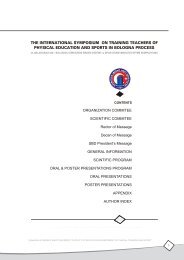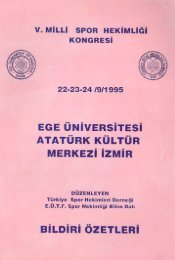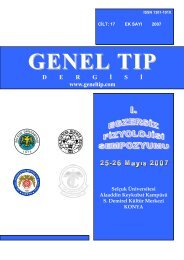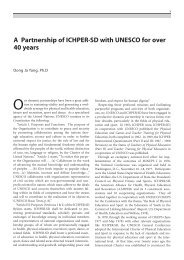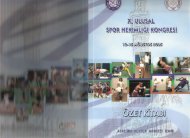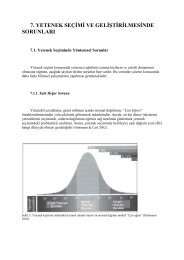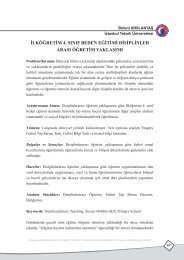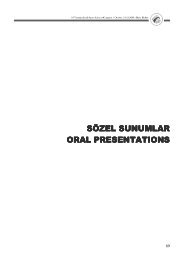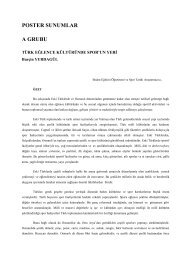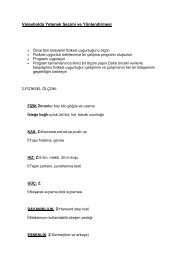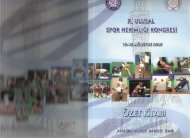7.ULUSLARARASI SPOR BİLİMLERİ KONGRESİ27-29 EKİM 2002KONGRE - PANELLERTwenty three national team members (mean age 16.1 ± 0.4 years, stature 1.71 ± 0.045 m and body mass65.8 ± 5.1 kg), in Portugal were studied by Garganta et al. (1993). Performance tests included a 4 x 5.5 mshuttle run, a standing vertical jump and a counter-movement jump. The elite players were superior in all thetests compared with a group of regional players. The somatotype of the elite players (2.3 ± 0.5 – 4.9 ± 0.7 – 2.5± 0.5) demonstrated their superior muscular make-up even at age 16. Leatt et al. (1987) reported a broadlysimilar pattern in Canadian young players, concluding that elite young football players have a somewhat aboveaverage height and mass, strong leg extensor muscles (particularly at high speeds of movement), a goodvertical jump and flexible hip joints. There was some evidence of selection by lean body mass in the under-16sand the additional muscle mass observed in the under-18s was attributed to prolonged training, possibly withspecific development of the fast-twitch muscle fibres.5. A Multivariate ApproachAny identification of physical and mental attributes necessary for success in sports is likely to be limited invalue unless complemented by information about proficiency in the skills of the game. For this reason anymultifactorial battery of tests for supporting the talent identification process should include assessment ofessential soccer skills. Tests for passing, shooting, controlling and dribbling the ball have been identified byReilly and Holmes (1983) as the principal components in assessment of skilled play.A multivariate approach towards testing for talented players was adopted by Reilly et al. (2000b). Theiraims were to i) design and apply a multivariate test battery for assessing talent in young soccer players and ii)determine the capability of distinguishing elite from sub-elite young players on the basis of such a test battery.Thirty one (16 elite, 15 sub-elite) young players matched for chronological age (15-16 years) and bodysize were studied. Test items included anthropometric (15), physiological (8), psychological (3) and soccerspecific skills (2) tests. Variables were split into separate groups according to somatotype, body composition,body size, speed, endurance, performance measures, technical skill, anticipation, task and ego orientation, andanxiety for purposes of univariate and multivariate analysis of variance and stepwise discriminant functionanalysis. The most discriminating of the measures were agility, sprint time, ego orientation and anticipation skill.The elite players were also significantly leaner, possessed superior aerobic power values (9.0 ± 1.7 vs. 55.5 ±3.8 ml.kg -1 .min -1 ) and a higher tolerance of fatigue (P
7.ULUSLARARASI SPOR BİLİMLERİ KONGRESİ27-29 EKİM 2002KONGRE - PANELLERis a product of many years of dedicated training, directed practice, soccer support networks, correct choices atcritical steps in development allied to inherited abilities and unremitting committment.ReferencesBangsbo, J. (1994). The physiology of soccer – with special reference to intense intermittent exercise. Acta PhysiologicaScandinavica, 15, Supplementum 619.Bar-Or, O. (1988). Adaptability of the musculoskeletal, cardiovascular and respiratory systems. In: The Olympic Book of<strong>Spor</strong>ts Medicine (edited by A. Dirix, H.G. Knuttgen and K. Tiltel), pp. 269-274. Oxford: Blackwell.Beunen, G. and Malina, R.M. (1988). Growth and physical performance relative to the timing of the adolescent spurt.Exercise and <strong>Spor</strong>ts Science Reviews, 16, 503-546.Beunen, G.P., Malina, R.M., Lefevre, J., Claessens, A.L., Renson, R. and Simons, J. (1997). Prediction of adult stature andnoninvasive assessment of biological maturation. Medicine and Science in <strong>Spor</strong>ts and Exercise, 29, 225-230.Borms, J. (1986). The child and exercise: an overview. Journal of <strong>Spor</strong>ts Sciences, 4, 3-20.Bouchard, C. and Lortie, G. (1984). Heritability and endurance performance. <strong>Spor</strong>ts Medicine, 1, 38-64.Bouchard, C. and Malina, R.M. (1983). Genetics of physical fitness and motor performance. Exercise and <strong>Spor</strong>t SciencesReviews II, 306-339.Bouchard, C., Malina, R.M. and Perusse, L. (1997). Genetics of Fitness and Physical Performance. Champaign, Ilinois;Human Kinetics.Brewer, J., Balsom, P. and Davis, J. (1995). Seasonal birth distribution amongst European soccer players. <strong>Spor</strong>ts Exerciseand Injury, 1, 154-157.Caru, B., Le Coultre, L., Aghemo, P. and Pinera Limas, F. (1970). Maximal aerobic and anaerobic muscular power in footballplayers. Journal of <strong>Spor</strong>ts Medicine and Physical Fitness, 10, 100-103.Claessens, A.L. (1999). Talent detection and talent development: kinanthropometric issues. Acta Kinesiologiae Tartuensis,4, 47-64.Ekblom, B. (1969). Effect of physical training in adolescent boys. Journal of Applied Physiology, 27, 350-5.Elliott, B.C., Bloomfield, J. and Davies, C.M. (1980). Development of the punt kick: a cinemalographical analysis, Journal ofHuman Movement Studies, 6, 142-150.Franks, A.M., Williams, A.M., Reilly, T. and Nevill, A. (1999). Talent identification in elite youth soccer players: physical andphysiological characteristics. Communication to the 4 th World Congress on Science and Football (Sydney).Garganta, J., Maia, J. and Pinto, J. (1993). Somatotype, body composition and physical performance capacities of eliteyoung soccer players. In Science and Football II (edited by T. Reilly, J. Clarys and A. Stibbe), pp. 292-294. London:E. and F.N. Spon.Gilliam, T.B. and Freedom, P.S. (1980). Effects of a 12-week school physical education program on peak 2 , bodycomposition and blood lipids in 7 to 9 year old children. International Journal of <strong>Spor</strong>ts Medicine, 1, 73.Jankovic, S., Matkovic, B.R. and Matkovic, B. (1997). Functional abilities and process of selection in soccer. In Proceedings9 th European Congress of <strong>Spor</strong>ts Medicine (Porto) 23-26 September.Klissouras, V. (1997). Heritability of adaptive variation: an old problem revisited. Journal of <strong>Spor</strong>ts Medicine and PhysicalFitness, 37, 1-6.Komadel, L. (1988). The identification of performance potential. In The Olympic Book of <strong>Spor</strong>ts Medicine Volume 1. (editedby A. Dirix, H.B. Knuttgen and K. Tittel) pp. 275-285. Oxford: Blackwell.Leatt, P., Shephard, R.J. and Plyley, M.J. (1987). Specific muscular development in under-18 soccer players. Journal of<strong>Spor</strong>ts Sciences, 5, 165-175.Lindquist, F. and Bangsbo, J. (1993). Do young soccer players need specific physical training. In Science and Football II(edited by T. Reilly, J. Clarys and A. Stibbe), pp. 275-280. London: E. and F.N. Spon.V O375



